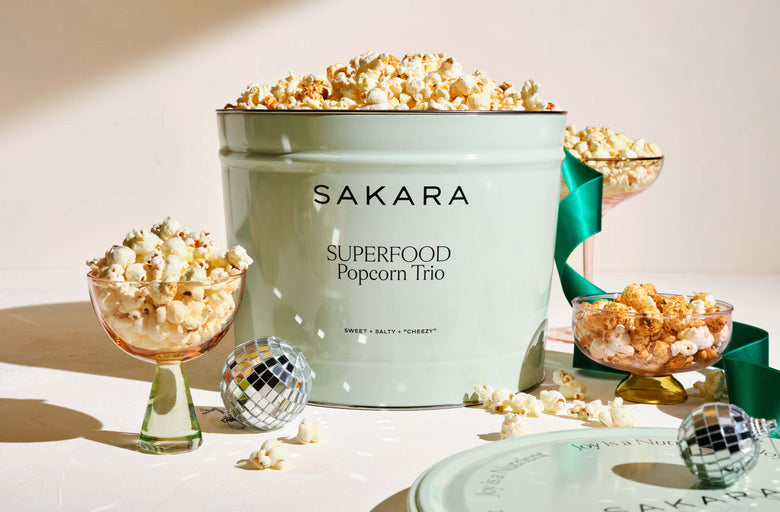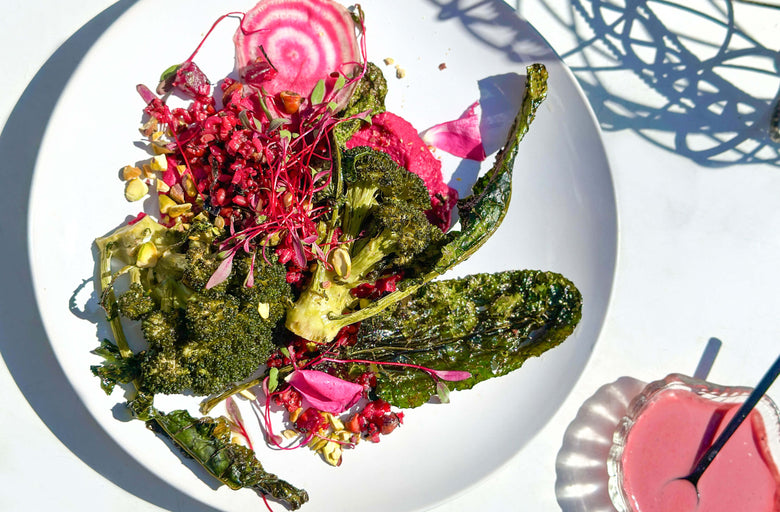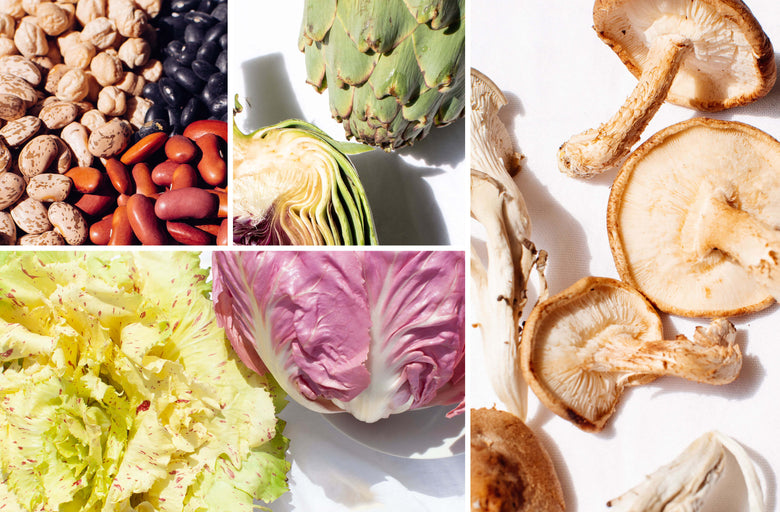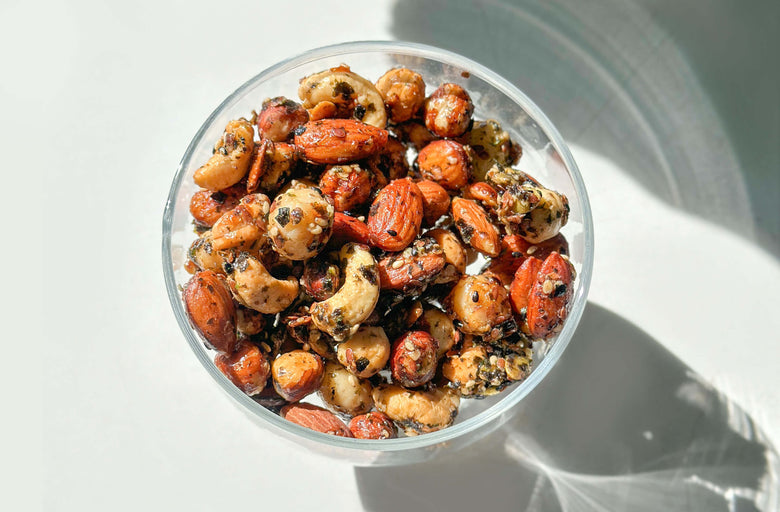Tired of the long lines at fast-casual restaurants that cater to the office crowd, you’ve decided to start bringing lunch to work. After some mental debating, a salad sounds good—nutritious, virtuous, not too heavy so as to put you asleep in your afternoon meeting. But will it satisfy? Or will you be left hungry and primed for boredom-induced snacking come 3 p.m.?
We’ve spent a lot of time thinking about what the perfect meal looks like (and what it tastes like, and how it nourishes body and spirit simultaneously), and we think we’ve cracked the code. The idea is to get creative, think abundantly, be flexible with the seasons, and celebrate your cravings. Follow our guidelines and skirt the sad desk lunch cliché for good.
Step 1: Start With Three to Four Cups of Leafy Greens
There is room for play (try tatsoi, rainbow chard, or broccoli microgreens) but the hard and fast rule remains—you must eat these fibrous, chlorophyll-rich plants because they will change your life. While many believe protein is the key to a toned body, the truth is that fiber is what the vast majority of Americans are deficient in, and what is required for a lean shape (not to mention health and overall longevity). Plant fiber is the critical food for the good-for-you microbes in your gut that are responsible for your mood, energy levels, sleep quality, sex drive, cognitive function, and even the way you absorb calories. Sakara founder and co-CEO, Danielle Duboise, believes greens are the ultimate key to shifting the American diet for the better: “My hope is that everyone would eat eight cups of leafy greens every day. And that people would begin to understand the power of food as medicine, not because I'm telling them, but because they feel it in their own bodies.”
Step 2: Include At Least Five Colors
Instead of keeping a monochromatic plate, fill it with color. Not only is this a pleasing sensorial experience, but each hue in nature represents specific antioxidants and minerals that boost beauty and vitality. Red, for example, is an expression of lycopene and anthocyanins, which squash inflammation and have been shown to offer anti-cancer properties; yellow plants translate to bromelain, a compound that aids in digestion; and though processed white foods are typically devoid of nutrients, in the wild, white plant foods are potent sources of ferulic acid and quercetin, which boost immunity. Aim to count at least five colors on your plate at each meal. Favor ORAC heavy hitters (plant foods that score highly for Oxygen Radical Absorbance Capacity) like artichokes, goji berries, spinach, beets, and beans, which have some of the highest concentrations of disease-fighting, age-defying, DNA-protecting antioxidants.
Step 3: Choose At Least One Water-Rich Ingredient
Dehydration is the ultimate brain fog machine: It creates inflammation, dries out the skin, and ultimately makes us look and feel tired. Your first inclination may be to tote around a liter-sized reusable water bottle, but the truth is that guzzling water is not the most effective method for hydration and the plump skin, detoxified organs, and ample energy that comes with it. The secret behind a dewy glow and a fast-working mind is eating your water. In water-rich foods, the H2O is trapped in a web of fiber, minerals, and electrolytes. When you eat these foods, the water stays in your body longer, aiding digestion, hydrating the kidney and colon, helping eliminate toxins, relieving bloat, and providing deep, cellular hydration and nourishment. Pharmacist Dr. Howard Murad recognizes the power in eating your water: “Our bodies are constantly regenerating, creating new cells to replace old, damaged ones. So, it is important that we eat and drink with a deliberate focus on promoting cellular health. The best way to do this is to keep our body saturated with cell-building elements such as vitamin A, alpha-lipoic acid, oleic acid, polyphenols, folic acid, and vitamin C—all nutrients found in water-rich plants.” Flood your cells with hydrating foods like melon, cucumber, radishes, celery, romaine, and tomatoes.
Step 4: Add Some Superfoods
Functional foods are nutritional workhorses that up the nutrient density of any meal. Take the goji berry, for example: This tiny medicinal fruit contains more carotenoids than other food and is chock-full of selenium and zinc, which are important minerals for skin integrity and hormone health. Or consider medicinal mushrooms, like chaga, used in Eastern medicine for millennia and a potent source of brain-loving B vitamins and flavonoids. Challenge yourself to incorporate them daily—a spoonful of turmeric in a smoothie here, a sprinkle of hemp seeds atop roasted veggies there. The results are subtle and cumulative, so stick with it and you may soon notice energy sans caffeine and a more focused and creative mind.
Step 5: Don’t Get Stuck in a Rut
Diversity on your plate is the holy grail to your healthiest body, so embrace change—with the seasons, your location, and your taste buds. With more than 25,000 phytonutrients on the planet, and more yet to be discovered, getting a wide range of plant foods in your diet is essential—not only for your enjoyment but for your all-important gut. There’s a reason the Sakara menu offers more than 200 different plant ingredients each week: Variation is what makes a plant-rich diet work because it creates a diverse makeup of bacteria in your gut. These complementary microbes work in synergy to stave off disease-causing inflammation and support lifelong health. Explore your grocery store or farmer’s market boldly and choose something new to add to your repertoire. Remember, there are no mistakes in cooking. And if all else fails, slow roast your veggies to simple perfection.
Step 6: Add a Healthy Fat
Though the ‘90s might have tried to make fat the villain, science has since taught us it’s actually essential to thriving health. Unsaturated fats tame inflammation, support mental wellbeing, and increase HDL cholesterol levels for a healthy heart. They also enable your body to absorb other nutrients on your plate (specifically A, D, E, and K). Incorporate a source of healthy fat into your DIY meals with a final flourish of salad dressing. Quality is key, so opt for organic, cold-pressed oils; you can also add nuts, seeds, or avocado to get the same benefits.
Below, a recipe for an effortless salad dressing that boosts brainpower. balances hormones, and adds some much-deserved indulgence—seriously, it makes everything taste better. Mix up a batch and store it in a mason jar in the fridge to elevate the nutrition and the satisfaction of any plant-forward meal.
Simple Maple + Dijon Dressing:
Ingredients (Makes 1 cup)
¼ cup tahini
¼ cup rice vinegar
¼ cup maple syrup
1 small shallot, minced
1 teaspoon Dijon mustard
½ teaspoon Himalayan salt, or more to taste
2 Tbsp hemp seeds
Directions:
- In a blender, combine all the ingredients except the hemp seeds with 2 tablespoons of water.
- Blend until smooth and stir in hemp seeds. Store in the fridge for up to five days.
So, there you have it: the perfect lunch (or dinner) in six steps. Within this framework, you have the freedom to explore—just keep quality top of mind. To quote Alice Waters: “When you have the best and tastiest ingredients, you can cook very simply and the food will be extraordinary because it tastes like what it is.” Quality starts with choosing organic produce, which will allow you to avoid endocrine-disrupting chemicals while receiving a higher dose of nutrients (research suggests there are actually more antioxidants and bioavailable compounds in organic produce than conventional). And don’t neglect one of the most important ingredients of all: joy. Ask yourself, "How can I inject happiness and thoughtfulness into mealtime?" Perhaps it’s adding a petite bouquet of edible flowers, plating your meal boldly instead of eating from a container while hunched over your computer, or upgrading your olive oil and salt to coax out maximum flavor. Three times a day, every day, you’re presented with the opportunity for gratitude, reflection, and best of all, pleasure—make it count.
For the time-deprived, what could be a bigger turn-on than ultra-nutritious, organic meals lovingly prepared and delivered ready to eat? If the above sounds too ambitious, here’s an elegant solution: a Sakara meal delivery program to bring it all to your door.






